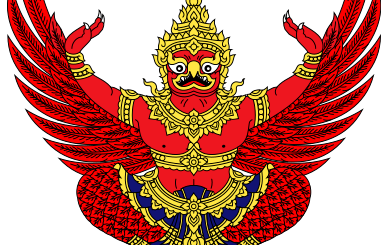History of Thailand and how it avoided European colonization
Thailand, officially known as the Kingdom of Thailand and formerly known as Siam until 1939, is a country steeped in rich history, diverse cultures, and significant transformations that have shaped its current identity.
And unbeknownst to many, Thailand is the only Southeast Asian nation that was never colonized by a European power, a point of pride that influences its cultural and political landscape to this day. How did Thailand manage to avoid being colonized? And who are some of the notable figures to have ruled Thailand?
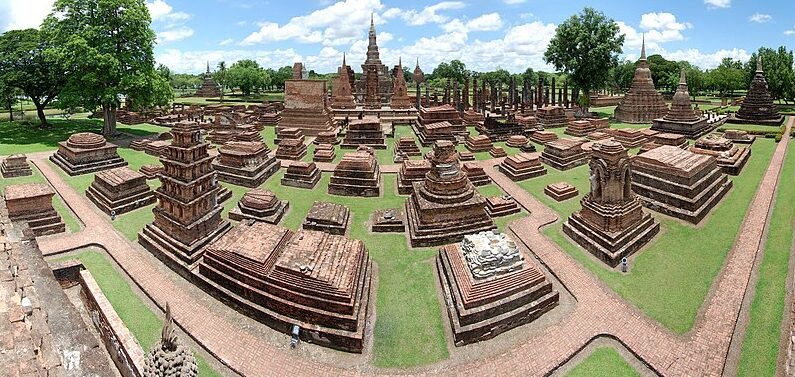
Thailand is a nation rich in history, culture, and natural beauty, which has evolved from a series of historical kingdoms and empires to its current status as a constitutional monarchy. Image: Wat Mahathat, an ancient Buddhist temple in central Thailand.
In the article below, WHE focuses on Thailand’s ancient kingdoms, colonial interactions, modern political developments, and cultural heritage.
Early Civilizations and Historical Foundations
The area now known as Thailand has been inhabited by humans since prehistoric times. The earliest evidence of rice cultivation and bronze-making indicates a sophisticated level of early human settlement.
By the first millennium AD, various tribal groups and chiefdoms were spread across the region, with significant influences from neighboring Indian and Chinese civilizations.
The first significant Thai kingdom was Sukhothai, established in the 13th century. It is here that the Thai script was developed and Theravada Buddhism was established as the predominant religion. The Sukhothai period is often viewed as a golden age of Thai culture, with a notable emphasis on religion and the arts.
Ayutthaya Period
Following Sukhothai, the kingdom of Ayutthaya emerged in the mid-14th century as the dominant force in the region. Located on an island surrounded by rivers, Ayutthaya became a powerful entity known for its sophisticated court life and became a center of international trade.
Trade with European nations began during this period, with the Portuguese being the first to establish diplomatic relations in the 16th century. Ayutthaya was a melting pot of cultures and ethnicities, bringing together Siamese, Chinese, Malay, Persian, and European influences.
However, Ayutthaya’s prosperity also attracted military challenges. After enduring wars with neighboring Burma and internal conflicts, the kingdom fell in 1767 when it was sacked by the Burmese army, leading to severe devastation.

The history of Thailand can be broadly categorized into several key periods: the early civilizations, the establishment and development of Thai kingdoms, the era of Western influence and modernization, and contemporary Thailand. Image: Flag of Thailand.
The Rise of Bangkok and Modernization
Following the fall of Ayutthaya, General Taksin established a new capital at Thonburi, and later, King Rama I moved the capital across the river to Bangkok in 1782, marking the beginning of the Chakri dynasty that continues to reign today. The new rulers not only reunited the fractured territories but also embarked on a process of consolidation and centralization.
The 19th century saw the arrival of Western powers in Southeast Asia, posing a colonial threat. Through skilled diplomacy and selective modernization, King Mongkut (Rama IV) and his son King Chulalongkorn (Rama V) navigated these challenges by forging treaties with Western powers and initiating comprehensive reforms in administration, education, and infrastructure, which effectively preserved Thailand’s sovereignty.
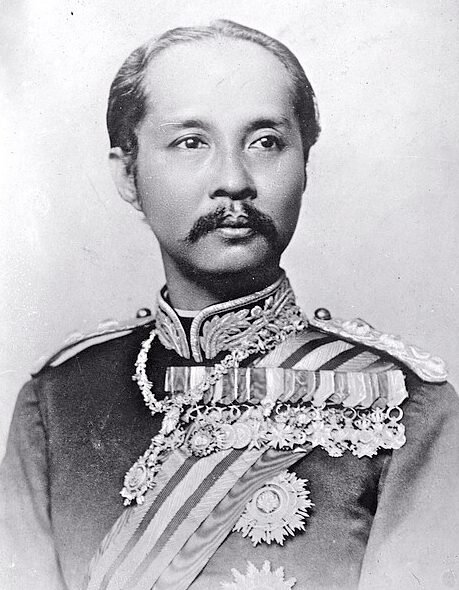
Reigning from 1868 to 1910, King Chulalongkorn implemented significant reforms that modernized Thailand, including abolishing slavery, reorganizing the government, modernizing the army, and improving infrastructure. His reforms laid the groundwork for Thailand’s modern state. Image: King Chulalongkorn (1853 – 1910).
20th Century Changes and Challenges
The 20th century was a period of great change for Thailand, marked by the transition from an absolute monarchy to a constitutional monarchy in 1932 after a peaceful coup led by civilian and military leaders.
This change ushered in an era of democratic experimentation interspersed with periods of military rule. Thailand’s role during World War II, aligning with Japan and later becoming an ally of the United States during the Cold War, also had significant impacts on its political landscape.
Post-war Thailand saw rapid economic growth, driven by agriculture, industry, and tourism, though it was often accompanied by political instability. The latter part of the 20th century was marked by a series of military coups, student protests, and efforts to stabilize and democratize the political system.
Did you know…?
- During World War II, Thailand allied with Japan. Post-war, it saw a revival of the monarchy’s political influence under Field Marshal Sarit Thanarat and aligned closely with the United States during the Cold War, playing a key anti-communist role in the region. In recent decades, Thailand has aimed to improve relations with Communist China and its neighboring countries.
- On the international stage, Thailand is considered a middle power and is a founding member of ASEAN. It boasts one of the largest economies in Southeast Asia, driven by manufacturing, agriculture, and tourism, and ranks highly on the Human Development Index.
Contemporary Thailand
Today, Thailand is a constitutional monarchy with a vibrant economy and a major tourist destination known for its rich cultural heritage, bustling cities, and picturesque landscapes.
The Southeast Asian nation remains politically complex, with the monarchy still playing a crucial role in Thai society and politics. Recent years have seen political protests demanding more democracy and reform, reflecting the ongoing evolution of Thai society.

Frequently asked questions about Thailand
Here are some frequently asked questions about Thailand, covering a variety of topics from history, travel and culture to geography and cuisine:
When did the Kingdom of Thailand form?
The Kingdom of Thailand, historically known as Siam, has roots going back to the first Thai kingdom of Sukhothai, established in 1238. The country was officially renamed Thailand in 1939, briefly reverted to Siam in 1945, and then permanently became Thailand again in 1949.
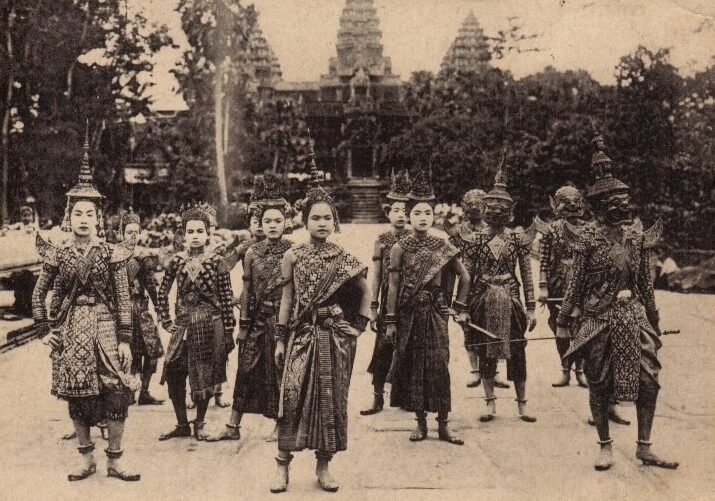
The area now known as Thailand has been inhabited by various peoples for more than three millennia. Early inhabitants included the Mon and Khmer people, who established several city-states and kingdoms across the region, influenced heavily by Indian culture and religion. Image: A group of traditional Khmer dancers during he 1920s.
Who are Thailand’s neighbors?
It is bordered by Myanmar (Burma) to the northwest, Laos to the northeast, Cambodia to the southeast, and Malaysia to the south. The country also has coastlines along the Gulf of Thailand to the south and the Andaman Sea to the southwest.
What is the best time to visit Thailand?
The best time to visit Thailand is during the cool and dry season between November and early April, when temperatures are more comfortable across the country. This period includes the peak tourist season.
What are the must-visit places in Thailand?
Key destinations include Bangkok for its vibrant street life and temples, Chiang Mai for its historical and cultural richness, Phuket and Koh Samui for beautiful beaches, and Ayutthaya for a glimpse into Thailand’s ancient history.
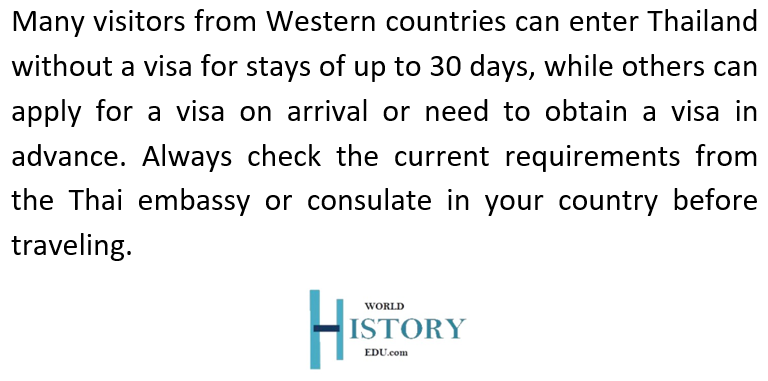
What is the currency of Thailand?
The currency of Thailand is the Thai Baht (THB). Currency exchange is widely available at airports, banks, and dedicated exchange services throughout major cities and tourist areas.
Is Thailand safe for tourists?
Thailand is generally safe for tourists. Common issues include petty theft and tourist scams, so it’s wise to stay vigilant, especially in crowded areas. Follow local advice and take usual travel safety precautions.
What should I avoid doing in Thailand to respect the local culture?
Important cultural norms include removing shoes when entering someone’s home or a temple, avoiding touching someone’s head as it’s considered sacred, and standing when the national anthem is played. Showing respect to images of the Buddha and the Royal Family is also crucial.
What are some traditional Thai dishes I should try?
Popular dishes include Pad Thai (stir-fried noodles), Tom Yum Goong (spicy shrimp soup), Som Tam (papaya salad), and Massaman Curry. Thai cuisine is known for its bold flavors and balance of sweet, sour, salty, and spicy components.
What is the language situation in Thailand?
The official language is Thai. English is widely taught in schools and is commonly used in the tourism industry and major cities, but less so in rural areas.
What are the major festivals in Thailand?
Major festivals include Songkran (Thai New Year, celebrated in April with water fights), Loy Krathong (festival of lights, held in November), and the Vegetarian Festival (a nine-day event celebrated mostly in Phuket with colorful processions and food stalls).
What is the significance of the Ayutthaya Kingdom in Thai history?
Founded in 1350, the Ayutthaya Kingdom is significant for its role in consolidating power and culture in the region, developing a sophisticated court culture, and engaging in extensive international trade. It lasted until 1767, when it was destroyed by Burmese forces.
How did Thailand avoid European colonization?
Thailand skillfully negotiated with European powers, particularly Britain and France, who were colonizing neighboring regions. Thai monarchs implemented reforms and modernizations that helped maintain sovereignty and demonstrated that Thailand could adapt and govern itself without foreign control.
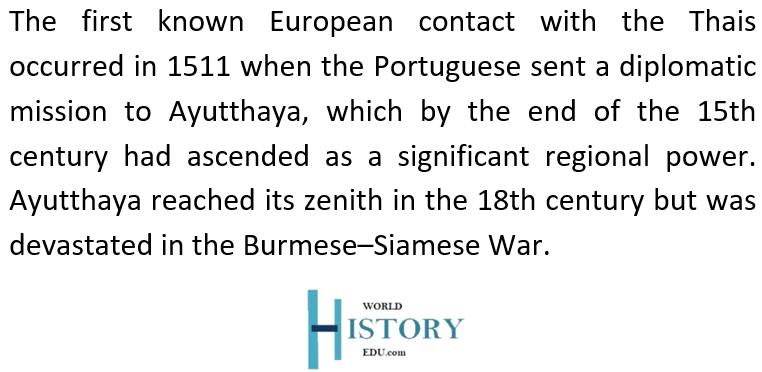
What led to the change from an absolute monarchy to a constitutional monarchy in Thailand?
In 1932, a bloodless coup led by a group of civil servants and military officers resulted in the transition from an absolute monarchy to a constitutional monarchy. The coup was motivated by a desire for democratic governance and a reaction to economic problems and the perceived inability of the monarchy to address them effectively.
How did Thailand’s role in World War II impact its history?
Thailand initially aligned with Japan during World War II, declaring war on the United States and the United Kingdom, but was treated as a puppet state by the Japanese. After the war, Thailand allied with the United States during the Cold War, which influenced its political and economic development.
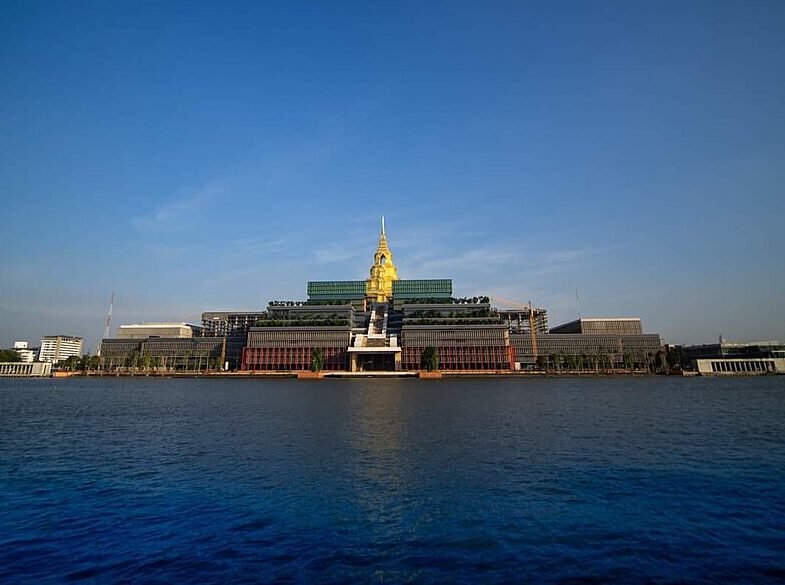
The 20th century in Thailand was marked by numerous military coups, political instability, and conflicts between democratic forces and military or aristocratic control. Issues such as economic inequality, corruption, and rural poverty also led to social and political tensions. Image: Thai parliament.
How has Thai history influenced its modern culture?
Thai history, with its mix of indigenous traditions and influences from India, China, and the West, has created a unique cultural identity that is evident in Thailand’s arts, cuisine, and societal norms. Historical themes of independence and adaptation are also prominent in Thailand’s national identity and policies.
What is the size of Thailand?
The Southeast Asian country covers 513,120 square kilometers and has a population of more than 70 million.

Neighboring Myanmar to the northwest, Laos to the northeast and east, Cambodia to the southeast, and Malaysia to the south, Thailand also has maritime borders with Vietnam, Indonesia, and India. Bangkok is its capital and largest city. Image: The skyline of Bangkok.
Where did the name Siam come from?
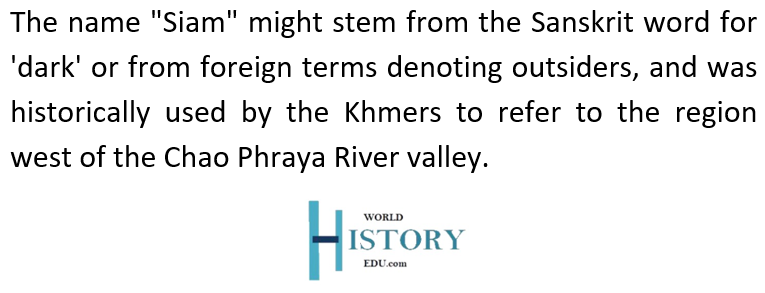
The name “Siam” possibly originated from Sanskrit (श्याम, śyāma, meaning ‘dark’) or Mon (ရာမည, rhmañña, ‘stranger’), linked to terms like Shan and Assam. Another hypothesis suggests it derives from the Chinese term ‘Xian’.
Additionally, ancient Khmers referred to the west Chao Phraya River valley region as Siam, a name possibly related to Lord Krishna (also known as Shyam).
Officially adopted in international treaties by King Mongkut in the mid-19th century, Siam was Thailand’s name until 1939, briefly reverted between 1946 and 1948, and then permanently changed back to Thailand.
Where did the name Thai come from?
The word “Thai” translates to ‘free man’ in the Thai language, distinguishing the Thai from those in servitude within the society. Another interpretation suggests that “Thai” simply means ‘people’ or ‘human being’, and was used instead of the more common word “khon” in some rural areas.
Etymologically, Thai-Tai could have evolved from a proto-word for ‘human being’. Thais commonly refer to their country as prathet Thai, and use the colloquial mueang Thai or just Thai, where “mueang” historically meant a city-state.
The formal name Ratcha Anachak Thai translates to ‘kingdom of Thailand’, with each component of the name derived from ancient languages signifying ‘king’, ‘authority’, and ‘power’.
